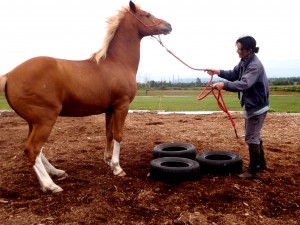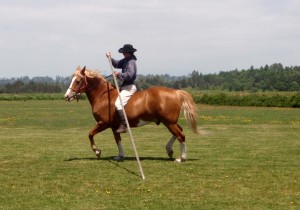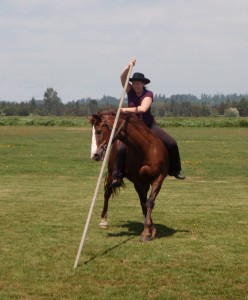How to H.E.M – Help, Explain and Motivate your horse – Part 9
|
|
H.E.M. – Helfen, Erklären und Motivieren – Teil 9
|
-
Explain:
- You can’t explain what you don’t know. Explaining something to your horse is factual and requires knowledge of the situation. It also requires possessing a common language, so a dialogue can take place. Your horse must understand your aids and clues. We speak, and hope he is willing to listen and learn. (If not, you have to jump to the Motivation chapter right away!)
- As an example let’s take game # 32 “Through tyres” on page 142 of my book „From Leading to Liberty“. Here the horse is supposed to understand that we want him to walk through a row of tyres laid out on the ground without putting his hooves down onto them.
1) What does he see?
- Put yourself in your horse’s hooves: It is no good to explain to him that these things are used car tyres! You need to explain to him what he wants to know, namely that they are not leg-hold traps, although they have all the appearance of being dangerous. When you introduce a new task – don’t try to force him!
Pulling is not allowed!
- Your horse sees a row of traps which will make him unable to flee… and he will most likely not see any reason at all why he should like that – until you make it appetizing and worthwhile! That falls under the motivation chapter!
- See the world through your horse’s eyes: If your horse refuses to go through a water puddle he might see the puddle as a deep hole, because of the reflection of the sky. If you throw in a pebble to break the reflection, the problem might be solved. So it helps to analyse where a problem lies – here the problem was not the water! This “thinking like a horse” falls under the help chapter!
|
|
-
Erklären:
- Man kann nicht erklären, was man selbst nicht weiß. Etwas erklären können hat mit Tatsachen zu tun, und bedingt daher, daß man die Situation kennt. Auch geht es nicht ohne gemeinsame Sprache, weil ein echter Dialog stattfinden muß. Ihr Pferd muß Ihre Hilfen und Kommandos verstehen können. Wir „sprechen“ und hoffen, daß es gewillt ist zuzuhören und zu lernen. (Ist das nicht der Fall, dann springen Sie gleich ins Motivationskapitel!)
- Nehmen wir als Beispiel unser Spiel # 32 “Durch Reifen” auf Seite 142 des Buchs „From Leading to Liberty“ (übrigens in sehr einfachem Englisch geschrieben und leicht verständlich). Hier soll das Pferd begreifen, daß es durch eine Reihe von Auto-reifen steigen soll ohne seine Hufe auf sie drauf zu setzen.
1) Was sieht Ihr Pferd ?
- Setzen Sie sich an seine Stelle: Es nützt nichts ihm zu sagen, daß das bloß Autoreifen sind! Sie müssen ihm erklären was es wissen will, nämlich daß das keine gefährlichen Fallen sind, obwohl sie so aussehen. Wenn Sie eine neue Aufgabe stellen – versuchen Sie nicht Ihr Pferd zu zwingen!
Ziehen ist nicht erlaubt!
- Ihr Pferd sieht Fallen – Objekte durch die es befürchtet fluchtunfähig gemacht zu werden… und es wird vermutlich nicht einsehen, warum das vergnüglich sein soll – bis Sie es die Sache wert machen! Das fällt unter das Motivations Kapitel!
- Man muß versuchen, die Welt durch seine Augen zu sehen: Wenn ein Pferd sich weigert durch eine Pfütze zu gehen, sieht es die Reflexion des Himmels vielleicht als ein tiefes Loch. Wenn Sie einen Kieselstein in die Pfütze werfen, um das Spiegelbild zu brechen, kann das Problem schon gelöst sein. Es hilft zu analysieren was das Problem verursacht – hier war es nicht das Wasser! Dieses „pferdisch Mitdenken“ fällt unter das Helfen – Kapitel!
|
 He simply can’t come closer yet – don’t pull !!!
|
2) What part of an exercise needs explanation?
- How to break down the steps of a learning sequence depends on the complexity of the game. The steps must be small enough, and the commands clear and concise enough, so your horse always has a real chance to get praised and feel clever. Determine the components of the exercise:
|
|
2) Welcher Teil einer Übung braucht vielleicht Erklärung?
- Wie man die Schritte einer Lernsequenz unterteilt hängt von der Komplexität des Spiels ab. Die Lernschritte müssen klein genug sein, und die Kommandos klar und genau genug, damit das Pferd eine realistische Chance hat gelobt zu werden und sich schlau fühlen zu können. Bestimmen Sie die Bausteine der Übung:
|
|
 
|
- In the Garrocha game for example the horse has to be well balanced on small circles in all gaits – and that on neck-reining aids, as we ride one-handed. We also previously “explained” prompt stops and fast turns, which then must be executed quite precisely under the Garrocha pole, especially, if you don’t want to lose your hat each time!
|
|
- Für das Garrocha-Spiel zum Beispiel muß das Pferd schon kleine Volten in allen Gangarten in guter Balance bewältigen können, und das auf Neck-Reining Hilfen, da man einhändig reitet. Auch „erklärt“ man vorher prompte Stopps und schnelle Drehungen, die dann unter der Garrocha-Stange sehr präzis sein müssen, vor allem, wenn man nicht immer dabei den Hut verlieren will!
|
|
| Read on in part 10: When does your horse need an explanation? |
|
Lesen Sie weiter im Teil 10: Wann braucht Ihr Pferd eine Erklärung? |
|
|
|
|
|
|
|
|




